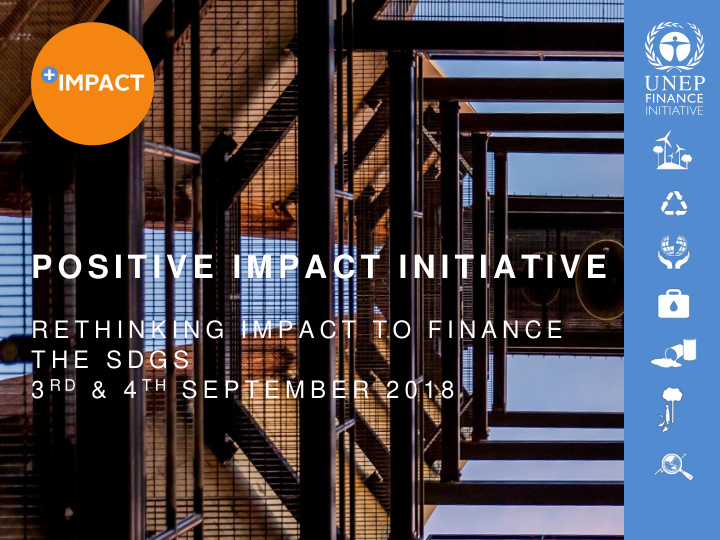



P O S I T I V E I M P A C T I N I T I A T I V E R E T H I N K I N G I M P A C T T O F I N A N C E T H E S D G S 3 R D & 4 T H S E P T E M B E R 2 0 1 8
UNEP FI’S POSITIVE IMPACT INITIATIVE Tools & guidance for holistic impact Principles for management Positive Impact Finance – moving towards a common language Positive Impact Manifesto – the need for an impact-based paradigm How to address the financing gap for sustainable development? 2
RETHINKING IMPACT TO FINANCE THE SDGS A POSITION PAPER & CALL TO ACTION • What do we mean by an impact-based paradigm? • What are the implications for the finance sector? • What about other stakeholders? 3
1. WHAT IS “THE FINANCING GAP”? Advanced countries Emerging markets & Africa developing countries 1.6 5 1.6 0.1 4.5 1.4 1.4 0.1 0.4 4 1.2 1.2 1.2 3.5 1 1 3 1.0 0.8 0.8 2.5 1.5 1.5 4.5 1.3 0.6 2 0.6 0.9 1.5 0.4 0.4 2.4 1 0.2 0.2 0.5 0.1 0 0 0 Figure 1: SDG financing gap - Advanced vs Emerging & Developing countries vs Africa Global financing gap: US$2.5 Tn, of which US$1.3 Tn in Africa, mainly in infrastructure 4
THE SDG FINANCING GAP IS FIRST AND FOREMOST A BUSINESS MODEL GAP MDBs DFIs ODA SWF FDI (greenfield) • Limitations in public and private financing REMITTANCES • Current private-public partnerships are not MICROFINANCE enough to overcome PRIVATE EQUITY these limitations CROWDFUNDING INSTITUTIONAL INVESTORS FOUNDATIONS Figure 2: SDG Financial Flows Relative to SDG Investment Needs 5
2. POSITIVE IMPACTS CAN BECOME PART OF BUSINESS MODELS 4 th industrial revolution: moving from product centred • strategies to multi-service strategies • Client and client needs are the new value generators • SDGs = fulfilling needs = creating positive impact > Positive impacts as carriers of financial value, rather than externalities Free services Client / Client For profit Needs services New Data services Figure 3: Business Model Evolution 6
EXAMPLE: THE MULTI-IMPACT LAMP-POST Security: Mobility: Security and mobility: Security, health & mobility: Emergency calls Street signs Street lighting CCTV, traffic monitoring air quality, etc. Energy: Communication: Solar panels Wi FI relay Business & culture: Energy & Communication: Advertisement Charging mobile devices Security & Mobility: Energy, Mobility, Air quality & Loudspeakers Health: Charging electric vehicles Biodiversity: Culture & well-being: Bird nests Esthetics, decorations (e.g.Christmas), etc. Figure 4 The multiple impacts of a lamp-post Repayment of investment via multiple service contracts (less • exposure to counterparty risk) Reduction of cost-to-impact ratio • 7
EXAMPLE: THE GLOBAL SERVICE COMPANY FOR ENERGY EFFICIENCY 6 5 4 3 2 1 Passive Energy Active Energy Public Utility Telecom Internet Global Service Efficiency Efficiency Company Business Company Manufacture Artificial Energy Telephone Internet Global Distribution Intelligence Supply Services services Integration Installer Connected Client Client Client of services: ESCO Object Database Database Database 2,3,4,5 & 6 Big Data Billing Billing Crunching ESCO Figure 5 Impact value chain – Energy Efficiency Integration of the impact value chain means the positive impact • (energy efficiency) can become the driver of the business model and enable significant growth Reduction of cost-to-impact ratio • 8
3. UNDERSTANDING & DRIVING CLIENTS’ & INVESTEES’ POSITIVE IMPACTS IS A MATTER OF STRATEGY Impact-based business + SDG No Consideration Consideration Holistic FINANCE consideration of negative of positive consideration of impacts impacts impacts of impacts NEW BUSINESS IMPROVING CURRENT BUSINESS MODELS MODELS - SDG FINANCE Figure 6 – The Impact Journey 9
IN PRACTICE… «Positive Impact Finance is that which serves to finance Positive Impact Business. It is that which serves to deliver a positive contribution to one or more of the three pillars of sustainable development, once any potential negative impacts to any of the pillars have been duly identified and mitigated.» The Principles for Positive Impact Finance Economic Environmental Social 10
NEXT STEPS – TOWARDS A POSITIVE IMPACT ECOSYSTEM Improving current business models Guidance & Tools for the implementation of the Principles • How to implement holistic impact analysis, building on frameworks Frameworks currently used by financial institutions’? What is a Principles – compliant product/service? • What impact categories to use to identify potential positive impact in Impacts the market and inside portfolios? How to monitor, measure and report on impact? New business models > Stimulating demand: impact-based programmes / requests for proposals 11
YOUR QUESTIONS, YOUR FEEDBACK What do you make of this new conception of impact-based business • and finance? 12
STAY TUNED Next PI Webinar: October, focus on implementation • Release of final position paper and first Principles guidance / tools • at the UNEP FI Global Roundtable, from 26-28 November in Paris. Positive Impact Updates: sign up online • http://www.unepfi.org/positive-impact/positive-impact/ 13
THE MORE FEEDBACK THE BETTER: HELP US SPREAD THE WORD Consultation open until 15 September. • Paper & feedback form available for download: http://www.unepfi.org/positive-impact/rethinking-impact/ • Twitter: #PositiveImpactNews • Linked-In: https://www.linkedin.com/feed/update/urn:li:activity:642787491518091 2640 14
THANK YOU Steering Group Secretariat • Andrew.Parry@hermes- • Careen.Abb@un.org investment.com • Elodie.Feller@un.org • • Denis.Childs@sgcib.com Jerome.Tagger@un.org • Leonie.Schreve@ing.com • Sabina.Timco@un.org • Mathilde.Dufour@mirova.com • Namita.Vikas@yesbank.in unepfi.org/positive-impact 15
Recommend
More recommend